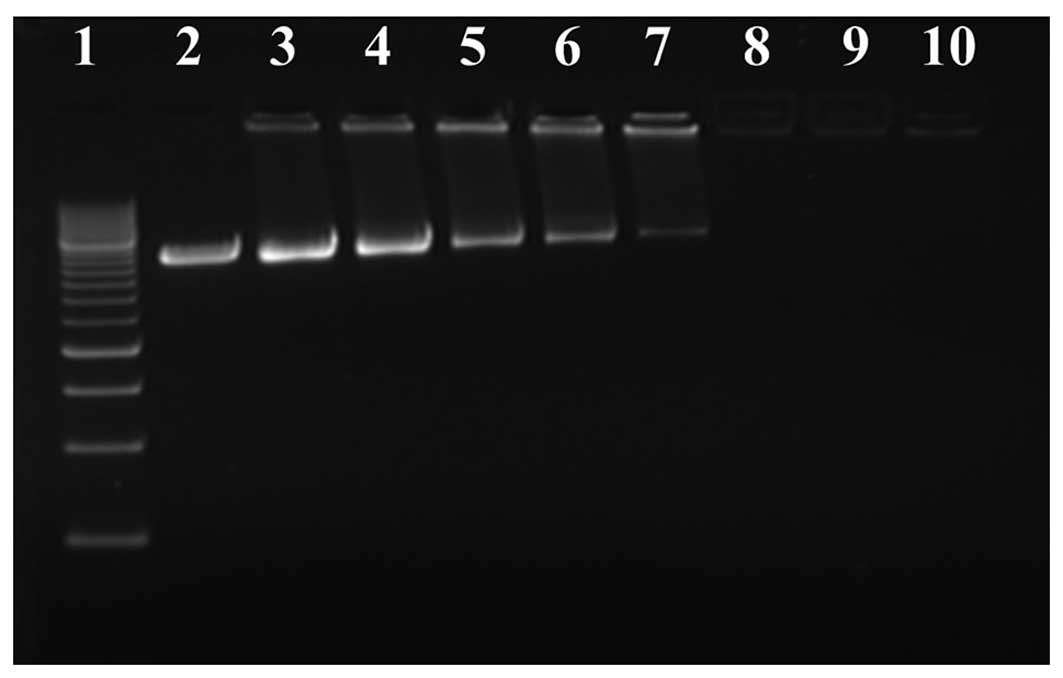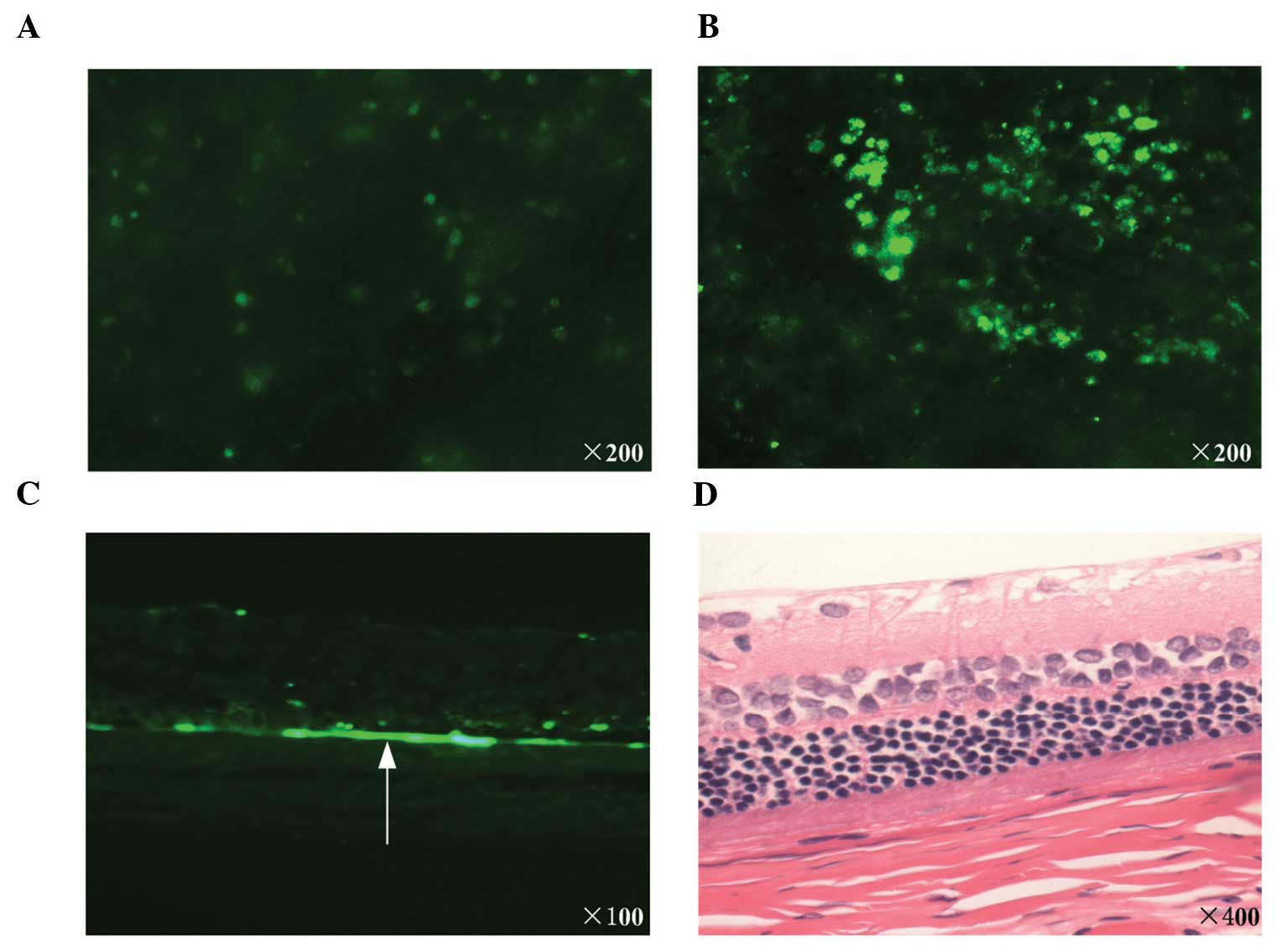|
1
|
Surace EM and Auricchio A: Versatility of
AAV vectors for retinal gene transfer. Vision Res. 48:353–359.
2008. View Article : Google Scholar
|
|
2
|
Zhang L, Li X, Zhao M, He P, Yu W, Dong J,
et al: Antisense oligonucleotide targeting c-fos mRNA limits
retinal pigment epithelial cell proliferation; a key step in the
progression of proliferative vitreo-retinopathy. Exp Eye Res.
83:1405–1411. 2006. View Article : Google Scholar : PubMed/NCBI
|
|
3
|
Lehrman S: Virus treatment questioned
after gene therapy death. Nature. 401:517–518. 1999. View Article : Google Scholar : PubMed/NCBI
|
|
4
|
Liu Q and Muruve DA: Molecular basis of
the inflammatory response to adenovirus vectors. Gene Ther.
10:935–940. 2003. View Article : Google Scholar : PubMed/NCBI
|
|
5
|
Sun JY, Anand-Jawa V, Chatterjee S and
Wong KK: Immune responses to adeno-associated virus and its
recombinant vectors. Gene Ther. 10:964–976. 2003. View Article : Google Scholar : PubMed/NCBI
|
|
6
|
Glover DJ, Lipps HJ and Jans DA: Towards
safe, non-viral therapeutic gene expression in humans. Nat Rev
Genet. 6:299–310. 2005. View
Article : Google Scholar : PubMed/NCBI
|
|
7
|
Park HJ, Yang F and Cho SW: Nonviral
delivery of genetic medicine for therapeutic angiogenesis. Adv Drug
Deliv Rev. 64:40–52. 2012. View Article : Google Scholar
|
|
8
|
Zhigang W, Zhiyu L, Haitao R, et al:
Ultrasound-mediated microbubble destruction enhances VEGF gene
delivery to the infarcted myocardium in rats. Clin Imaging.
28:395–398. 2004. View Article : Google Scholar : PubMed/NCBI
|
|
9
|
Zhang Q, Wang Z, Ran H, et al: Enhanced
gene delivery into skeletal muscles with ultrasound and microbubble
techniques. Acad Radiol. 13:363–367. 2006. View Article : Google Scholar : PubMed/NCBI
|
|
10
|
Ren JL, Wang ZG, Zhang Y, et al:
Transfection efficiency of TDL compound in HUVEC enhanced by
ultrasound-targeted micro-bubble destruction. Ultrasound Med Biol.
34:1857–1867. 2008. View Article : Google Scholar : PubMed/NCBI
|
|
11
|
Sonoda S, Tachibana K, Uchino E, et al:
Gene transfer to corneal epithelium and keratocytes mediated by
ultrasound with micro-bubbles. Invest Ophthalmol Vis Sci.
47:558–564. 2006. View Article : Google Scholar : PubMed/NCBI
|
|
12
|
Li HL, Zheng XZ, Wang HP, Li F, Wu Y and
Du LF: Ultrasound-targeted microbubble destruction enhances
AAV-mediated gene transfection in human RPE cells in vitro and rat
retina in vivo. Gene Ther. 16:1146–1153. 2009. View Article : Google Scholar : PubMed/NCBI
|
|
13
|
Neu M, Fischer D and Kissel T: Recent
advances in rational gene transfer vector design based on poly
(ethylene imine) and its derivatives. J Gene Med. 7:992–1009. 2005.
View Article : Google Scholar : PubMed/NCBI
|
|
14
|
Weerasinghe P, Li Y, Guan Y, Zhang R,
Tweardy DJ and Jing N: T40214/PEI complex: a potent therapeutics
for prostate cancer that targets STAT3 signaling. Prostate.
68:1430–1442. 2008. View Article : Google Scholar : PubMed/NCBI
|
|
15
|
Hu YZ, Zhu JA, Jiang YG and Hu B:
Ultrasound microbubble contrast agents: application to therapy for
peripheral vascular disease. Adv Ther. 26:425–434. 2009. View Article : Google Scholar : PubMed/NCBI
|
|
16
|
Qin S, Caskey CF and Ferrara KW:
Ultrasound contrast microbubbles in imaging and therapy: physical
principles and engineering. Phys Med Biol. 54:R27–R57. 2009.
View Article : Google Scholar : PubMed/NCBI
|
|
17
|
Chen YC, Jiang LP, Liu NX, Wang ZH, Hong K
and Zhang QP: P85, Optison microbubbles and ultrasound cooperate in
mediating plasmid DNA transfection in mouse skeletal muscles in
vivo. Ultrason Sonochem. 18:513–519. 2011. View Article : Google Scholar
|
|
18
|
Chen S, Shimoda M, Wang MY, et al:
Regeneration of pancreatic islets in vivo by ultrasound-targeted
gene therapy. Gene Ther. 17:1411–1420. 2010. View Article : Google Scholar : PubMed/NCBI
|
|
19
|
Koike H, Tomita N, Azuma H, et al: An
efficient gene transfer method mediated by ultrasound and
microbubbles into the kidney. J Gene Med. 7:108–116. 2005.
View Article : Google Scholar
|
|
20
|
Sunshine JC, Bishop CJ and Green JJ:
Advances in polymeric and inorganic vectors for nonviral nucleic
acid delivery. Ther Deliv. 2:493–521. 2011. View Article : Google Scholar : PubMed/NCBI
|
|
21
|
del Pozo-Rodríguez A, Delgado D, Solinís
MA, Gascón AR and Pedraz JL: Solid lipid nanoparticles for retinal
gene therapy: transfection and intracellular trafficking in RPE
cells. Int J Pharm. 360:177–183. 2008. View Article : Google Scholar : PubMed/NCBI
|
|
22
|
Urtti A, Polansky J, Lui GM and Szoka FC:
Gene delivery and expression in human retinal pigment epithelial
cells: effects of synthetic carriers, serum, extracellular matrix
and viral promoters. J Drug Target. 7:413–421. 2000. View Article : Google Scholar : PubMed/NCBI
|
|
23
|
Sunshine JC, Sunshine SB, Bhutto I, Handa
JT and Green JJ: Poly (β-amino ester)-nanoparticle mediated
transfection of retinal pigment epithelial cells in vitro and in
vivo. PLoS One. 7:e375432012. View Article : Google Scholar
|
|
24
|
Park J, Zhang Y, Vykhodtseva N, Akula JD
and McDannold NJ: Targeted and reversible blood-retinal barrier
disruption via focused ultrasound and microbubbles. PLoS One.
7:e427542012. View Article : Google Scholar : PubMed/NCBI
|
|
25
|
Yanagisawa K, Moriyasu F, Miyahara T, Yuki
M and Iijima H: Phagocytosis of ultrasound contrast agent
microbubbles by Kupffer cells. Ultrasound Med Biol. 33:318–325.
2007. View Article : Google Scholar : PubMed/NCBI
|
|
26
|
Kircheis R, Wightman L, Schreiber A, et
al: Polyethylenimine/DNA complexes shielded by transferrin target
gene expression to tumors after systemic application. Gene Ther.
8:28–40. 2001. View Article : Google Scholar : PubMed/NCBI
|













